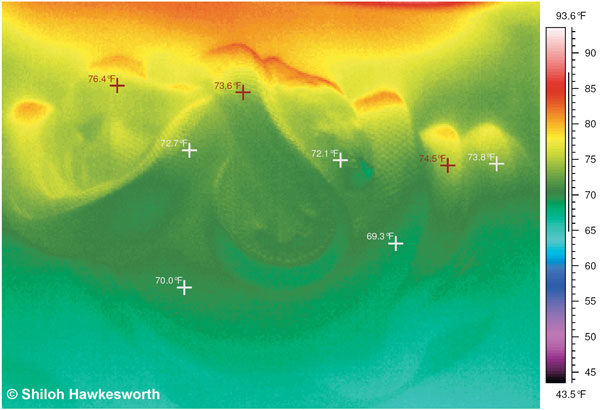Supplement to the February 2008 REPTILES magazine article "Heat Seeker."
In the Heat of Passion
To take things one step further, we took an image of a pair mating in the new-style cage. This image gave a much better thermal color representation of the snake’s normal body temperatures.

A male and female green tree python mate in this thermal image. White plus signs represent the female’s temperature. Red plus signs represent the male’s temperature. The author took several images, and in each case the male was warmer..
We also noticed the male’s body temperature was warmer than the female’s. We took several more images of this pair, and all displayed the same variance between the two snakes. We later did tests on four more pairs. They were tested just before being paired and during breeding, and we saw the same temperature difference between the sexes as before. The females’ lower temperature might attribute to their bodies preparing to retain sperm, which last longer in lower temperatures. Outside of the breeding season, the males’ temperatures were almost the same as females’.
Green Tree Python Challenges
Many advancements have been made in green tree python husbandry since the species was first brought to the United States in the early 1970s. These pythons were originally kept in screen-type enclosures much like cages designed for chameleons. Hobbyists know today that these snakes require much higher maintenance than the average snake, and most care for them accordingly. Green tree pythons kept in enclosures that do not meet the basic guidelines can run into problems. They might not eat, they might have bad sheds, and they might even acquire a respiratory infection. These snakes are also considered solitary animals, and they are not usually housed with others outside of breeding. One python per cage is typical.
Arboreal Cage Challenges
Green tree pythons require fairly specific temperatures and humidity. Native to the rain forests and jungles of Papua New Guinea, Indonesia and Cape York, Australia, they should be kept in temperatures around 80 to 90 degrees Fahrenheit, and they require higher humidity than most reptiles. Mimicking nature’s cycles can prove to be difficult if your cage is not suited to the task. These snakes need heat and moisture, but heat often dries moisture. In this situation one need battles the other.
Want to read the full story? Pick up the February 2008 issue of REPTILES today, or subscribe to get 12 months of articles just like this.



